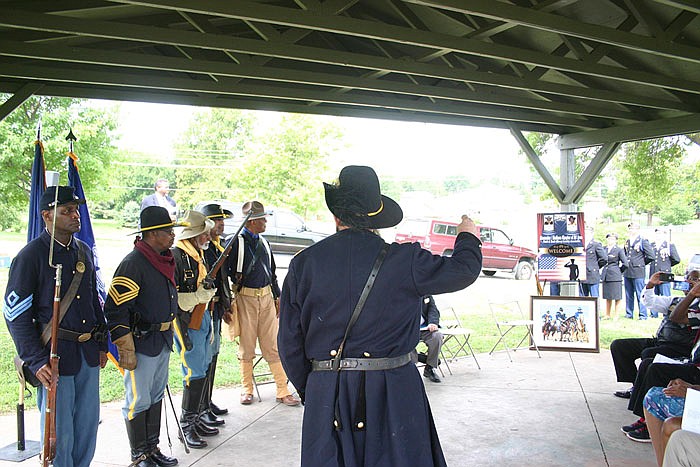As Lincoln University marked its official 150th anniversary Saturday for the opening of a school to teach newly freed slaves, so the Buffalo Soldiers first mustered into service 150 years ago this week.
"Most people don't realize the Buffalo Soldiers also are having a sesquicentennial," Lincoln University professor Essex Garner said.
The art professor's work is steeped in history, a major collection dedicated to the Buffalo Soldiers.
"History cannot be forgotten because if we forget our true history, as ugly as it is; if our millennials forget our mistakes; history at some point will repeat itself," Garner said, adding he emphasizes this to each of his students and at speaking engagements.
Garner also is a trooper in the re-enactment group, the Greater Kansas City-Leavenworth Area Chapter of the Buffalo Soldiers. Recently, they gathered in Leavenworth, Kansas, to commemorate the regiment's 150th and Garner was there in his Union-blue uniform and rifle in hand.
The observation was held to "honor the African-American cavalry and infantry regiments that became the first black military formations in the standing 'peacetime' regular army," the Buffalo Soldier newsletter said. "These black enlisted men and their white officer corps became legendary in their military exploits in the frontier west, the Spanish American War and the wars and conflicts that followed."
Following the Civil War, society saw the influx of freed slaves who had not been able to go or do things on their own, Garner noted. For many of the U.S. Colored Troops, they were armed with literacy and awakened to a broader future. That's why many Historically Black Colleges and Universities across the nation were founded in the following years.
For other black soldiers, military life suited them. The formation of the Buffalo Soldiers gave them an avenue for advancement in a legitimate occupation, Garner said.
New Orleans and Fort Leavenworth were the mustering points for the Ninth and Tenth Cavalry.
"Most historians and the general public are unaware of the amazing exploits of these men, many of whom were veterans of the Union Army during the American Civil War," the newsletter said.
They operated west of the Mississippi River, engaging hostile Native Americans and protecting westward immigrants, according to the History Channel website.
The Buffalo Soldiers fought in Cuba during the Spanish-American War and with Gen. John Pershing in the hunt for Mexican revolutionary Pancho Villa. The organization ended after President Harry Truman issued an executive order in 1948 eliminating racial segregation in the armed forces.
By drawing attention to the Buffalo Soldiers anniversary, the modern-day organization hopes "to provide a stronger sense of African-American contributions to American military history and a tremendous sense of honor and pride," the newsletter said.
For Garner, a four-day separation between the opening of Lincoln University and the enlistment of the first Buffalo Soldiers is significant.
Garner became an expert on the U.S. Colored Infantry while preparing his master's thesis at the University of Missouri and connected with the Buffalo Soldiers Chapter.
The two organizations began just months after blacks were freed following the close of the Civil War.
Lincoln was founded by soldiers in the 62nd and 65th U.S. Colored Infantry because they wanted to share the opportunity of literacy and expectations of citizenship in the same way their white officers had shared with them.
Serving in the Union, these soldiers had to overcome stereotypes and negative assumptions about how their race would respond in the military, Garner said.
As the Battle of Island Mound, the very first engagement between black soldiers and Confederate troops, proved, "colored soldiers showed the could fight," Garner said. "But in 1863, they were not used for fighting."
Despite the unequal treatment of black and white soldiers, black soldiers persevered. And that continued through the Tuskegee Airmen of World War II and in Korea before desegregation during the Vietnam War.
"The worst parts of the wars, that's where you'd find the black soldier," Garner said.

